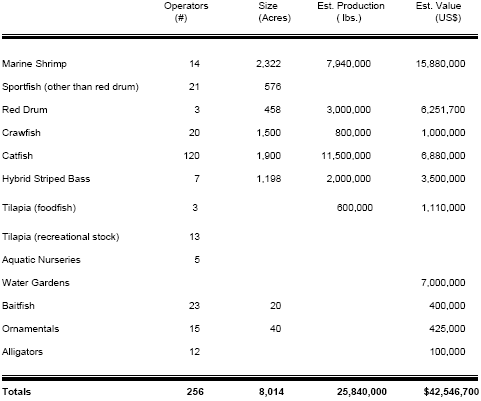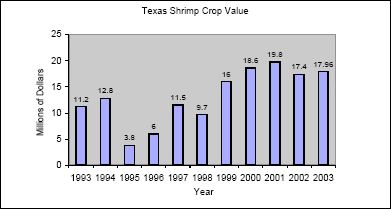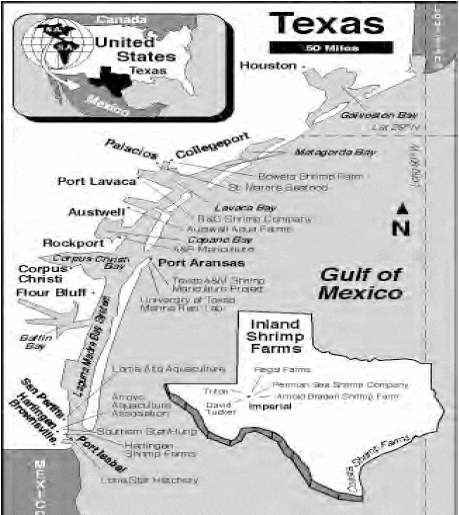The aquaculture industry makes a total economic impact of over $US127 million to the state's
economy, considering all the spin-offs from the industry such as: jobs (on farms, in shrimp and fish processing, packaging, cold storage, shipping, and in retailing seafood); agricultural products (corn, wheat, soy beans, and other products used in feeds); and restaurant sales. The largest aquaculture production crop in the state is channel catfish (11.5 million pounds worth $6.9 million in 2404). There are 1,900 acres of catfish ponds now and if the average production of 8,900 Ibs/ac in a 14 to 16 month growout occurs, the state should see approximately 16.9 million pounds of catfish produced in 2005.
The second largest production crop and most valuable crop is Litopenaeus vannamei, the Pacific White Shrimp, which set a state production record in 2003 at 4,081 metric tons or 9 million pounds, worth a farm-gate price of US$18 million. In the last 13 years, the Texas shrimp
aquaculture industry produced 61 million pounds of shrimp with a farm-gate value of approximately $US171 million, generating a $US 513 million economic impact on the state's economy. However, for the last two years marine shrimp production in Texas has decreased (2004 - 7.94 million pounds and 2005 - 6.83 million pounds).
With some coastal shrimp farms converting to hybrid striped bass production, there are now 1,200 acres of hybrid striped bass production in the state, with an estimated 2 million pounds of fish annually. There are three red drum (Sciaenops ocellatus) facilities on the Texas coast with 458 surface acres, producing an average of 3 million pounds annually, worth $US 6.3 million. One farm donated 30,000 redfish to the state's inland fisheries stock enhancement program in 2004 for recreational fishing at 3 inland power plant cooling lakes. Several tilapia farms in the state produce at least 600,000 pounds of fish annually.
The Texas Aquaculture Industry also has a large aquatic plant or water garden industry, with very large ornamental fish sales. It is estimated that water gardens generate 7 million dollars in sales annually in Texas. Bait fish, as well as stocker fish for recreational ponds are also big business in Texas.
There is also great potential for offshore aquaculture in the Gulf of Mexico. According to NOAA - NMFS Statistics No. 2003, the total fish and shellfish production for the Gulf of Mexico in 2003 was 194 million pounds, excluding Menhaden and shrimp.
According to Joe Hendrix of Sea Fish Mariculture in Houston, 457 cages (32 meter diameter) carrying 20 kg/cubic meter of fish could produce the entire annual commercial finfish catch of the Gulf, requiring a sea bottom area of only 800 hectares or about 2,000 acres. Of course you would not want to put the fish in a concentrated area, but would spread them out over the Gulf. The potential for offshore - aquaculture in the Gulf of Mexico offers the US a way to offset its huge seafood trade deficit, and produce its own fish. The Texas aquaculture industry has great potential in the future helping the U.S. offset its seafood trade deficit.
According to USDA, the U.S. will import $11 billion of fish
and shellfish and will export $3.6 billion worth of fish and shellfish in 2005, leaving a $7.4 billion seafood trade deficit. With the rising consumption of seafood worldwide, partly because of the health benefits, per capita consumption of seafood continues to increase. Wild fisheries cannot meet the rising demand. The total value of U.S. Aquaculture is about $6 billion and the U.S. industry supports at least 181,000 full-time jobs. Aquaculture continues to be the fastest growing sector of U.S. agriculture.
The state has strong aquaculture research and extension programs, and a strong support organization, the Texas Aquaculture Association (TAA). More information can be obtained about the industry and TAA on this web site (www.texasaquaculture.org}.
Like other farm related industries some of the farm-gate seafood prices fluctuate, but
production has been good, and according to the Texas Department of Agriculture there were 19
new aquaculture farms permitted in 2003, mostly catfish. With catfish production increasing and
rising farm-gate prices for catfish, this sector is further stimulating interest and activity in
aquaculture. Catfish is considered the silent giant. The industry is growing quietly.
Table 1 shows the breakdown of state-wide production by number of producers, area
under water, production and farm-gate price received by the farmer.

Marine Shrimp
The 21st Annual Texas Shrimp Farming Short Course will be offered in Sept. 2006. More detail can be found at http://texas-sea-grant.tamu.edu/short_course.php. The 7 day course is free.
Texas produces more farm-raised shrimp than any other state in the United States and accounted for 80 percent of the US domestic production in 2003 (12 million pounds in US versus 9 million pounds in Texas).
In 2004 Texas produced 65 percent of the US farm-raised shrimp
(12.3 million pounds in US versus 7.94 million pounds in Texas). In the last 13 years, the Texas shrimp aquaculture industry produced 61 million pounds of farm-raised shrimp with a farm-gate value of $171 million, generating a $ 513 million economic impact on the state's economy. But production in the state has decreased since 2003. 2004 production was 7.94 million pounds and 6.83 million pounds were produced in 2005.
Raised with high standards and constant control, farm-raised shrimps offer consumers an excellent choice of seafood. In 2003,15 shrimp farms produced a record 9 million pounds valued at $18 million. The state's farm-raised shrimp production steadily increased from 1996 to 2003,
but dropped in 2004 to 7.94 million pounds, worth $15,880,000 and dropped again in 2005 to 6.83 million pounds of whole shrimp.
In 2004, the drop in production was due partly to the Taura Syndrome Virus (TSV) in South Texas and fewer ponds were stocked because of lower prices. There are approximately 3,000 acres of shrimp culture ponds in Texas with approximately 479 ponds constructed, but not all are being used. Only 2,343 acres were stocked in 2004 and even fewer were stocked in 2005. Only 1,906 acres were used to grow shrimp in 2005. Figure one shows Texas shrimp aquaculture production since 1987.

Shrimp wholesale or farm-gate prices failed to keep pace with the record production in 2002 and 2003, and prices remained low throughout 2004, 2005 and into 2006. The farm-gate price for shrimp in Texas averaged $2.00 per pound, but varied according to size. Generally since 2002, the average farm gate prices bring $3.OOlib for 30 gram shrimp; $2.OOllb for 20 gram shrimp and $1.OOllb for 10 gram shrimp.

Figure 2 shows the total farm-gate price of heads on shrimp in Texas from 1993 to 2003. 2004
farm gate total was 15.88 and 2005 13.66 million dollars.
Figure 3 (from Bob Rosenberry, Shrimp News International) shows the location of past Texas
shrimp farms. Not all are currently operating. For example, R&G farm is now operating as a
hybrid striped bass farm; A&P Mariculture has closed; only Permian Sea Shrimp Company
continues to produce shrimp in west Texas. The other west Texas farms are either for sale or
have closed. Lone Star Hatchery closed. Southern Star is being leased to several different
operators, including Bowers Valley.

Further Information
To continue reading this article, click here (PDF)
Source: Texas Aquaculture Association - June 2006

